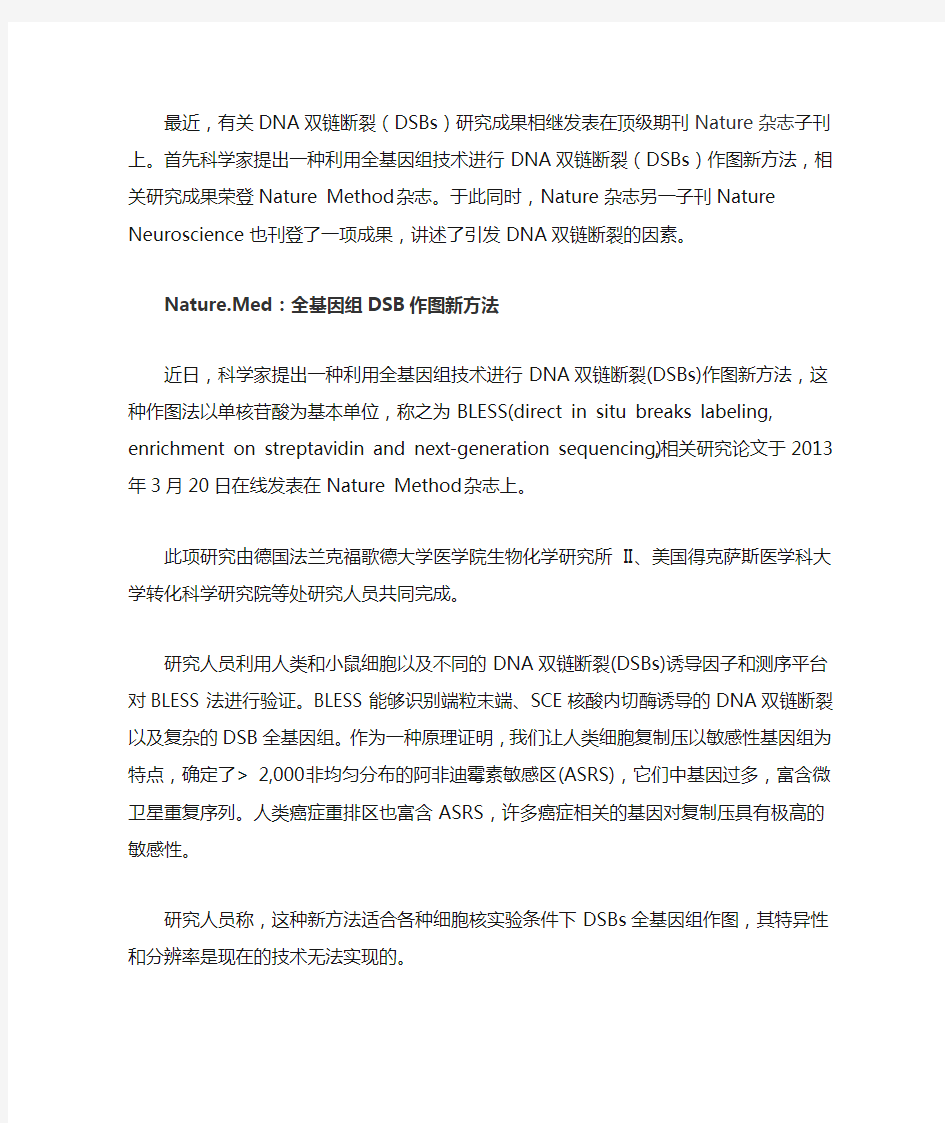聚焦DNA双链断裂(DSBs)

- 1、下载文档前请自行甄别文档内容的完整性,平台不提供额外的编辑、内容补充、找答案等附加服务。
- 2、"仅部分预览"的文档,不可在线预览部分如存在完整性等问题,可反馈申请退款(可完整预览的文档不适用该条件!)。
- 3、如文档侵犯您的权益,请联系客服反馈,我们会尽快为您处理(人工客服工作时间:9:00-18:30)。
最近,有关DNA双链断裂(DSBs)研究成果相继发表在顶级期刊Nature杂志子刊上。首先科学家提出一种利用全基因组技术进行DNA双链断裂(DSBs)作图新方法,相关研究成果荣登Nature Method杂志。于此同时,Nature杂志另一子刊Nature Neuroscience也刊登了一项成果,讲述了引发DNA双链断裂的因素。
Nature.Med:全基因组DSB作图新方法
近日,科学家提出一种利用全基因组技术进行DNA双链断裂(DSBs)作图新方法,这种作图法以单核苷酸为基本单位,称之为BLESS(direct in situ breaks labeling, enrichment on streptavidin and next-generation sequencing),相关研究论文于2013年3月20日在线发表在Nature Method杂志上。
此项研究由德国法兰克福歌德大学医学院生物化学研究所 II、美国得克萨斯医学科大学转化科学研究院等处研究人员共同完成。
研究人员利用人类和小鼠细胞以及不同的DNA双链断裂(DSBs)诱导因子和测序平台对BLESS法进行验证。BLESS能够识别端粒末端、SCE核酸内切酶诱导的DNA双链断裂以及复杂的DSB全基因组。作为一种原理证明,我们让人类细胞复制压以敏感性基因组为特点,确定了> 2,000非均匀分布的阿非迪霉素敏感区(ASRS),它们中基因过多,富含微卫星重复序列。人类癌症重排区也富含ASRS,许多癌症相关的基因对复制压具有极高的敏感性。
研究人员称,这种新方法适合各种细胞核实验条件下DSBs全基因组作图,其特异性和分辨率是现在的技术无法实现的。
罗格斯大学的神经遗传学家 Karl Herrup表示,这项工作令人惊叹。DNA
损伤对神经元的伤害极其危险。它无可更换,细胞必须从这些断裂中获取某些有价值的物质。Herrup并未参与此项研究。
加州大学神经科医生 Lennart Mucke,在他研究改变阿尔茨海默氏病(AD)基因组稳定性,偶然发现这种逮捕概念:切断和修复DNA是正常大脑活动的一部分。AD特征ß是淀粉样蛋白和受损的神经元DNA纠结成块。带着期望了解更多有关DNA损伤及其相关高水平的淀粉样蛋白,Mucke的团队将研究焦点放在双链DNA断裂上,这是神经科学家认为最严重的损伤形式。
此研究小组揭示了一种自然行为,如探索一种新环境,能引起野生型年轻成年小鼠DNA双链断裂(DSBs)。DNA双链断裂(DSBs)发生在多个脑区域,但在海马齿状回神经最丰富。海马齿状回神经参与学习和记忆,能在24小时内修复。感受器或光刺激下增加的神经元活动,增加了相关神经元DNA双链断裂(DSBs),而非不相关的神经网络。
人淀粉样前体蛋白(hAPP)转基因小鼠增加了基线神经元DNA双链断裂(DSBs),且在探索新环境后出现严重和长期的DSBs。其中hAPP可刺激AD关键方面。
hAPP 小鼠中,抑制神经元异常活动的中断以及学习和记忆提高,使小鼠中DNA双链断裂(DSBs)水平正常化。神经细胞培养中,阻断突触外NMDA型谷氨酸
受体能阻止β-淀粉样蛋白(Aβ)诱导的DNA双链断裂(DSBs)。因此,神经细胞DNA双链断裂(DSBs)的明显增加,是由于大脑生理活动引发的,且β-淀粉样蛋白(Aβ)加剧DNA损伤极有可能是由于突触功能障碍引发的。
原文摘要:
Nucleotide-resolution DNA double-strand break mapping by
next-generation sequencing
We present a genome-wide approach to map DNA double-strand breaks (DSBs) at nucleotide resolution by a method we termed BLESS (direct in situ breaks labeling, enrichment on streptavidin and next-generation sequencing). We validated and tested BLESS using human and mouse cells and different DSBs-inducing agents and sequencing platforms. BLESS was able to detect telomere ends, Sce endonuclease–induced DSBs and complex genome-wide DSB landscapes. As a proof of principle, we characterized the genomic landscape of sensitivity to replication stress in human cells, and we identified >2,000 nonuniformly distributed aphidicolin-sensitive regions (ASRs) overrepresented in genes and enriched in satellite repeats. ASRs were also enriched in regions rearranged in human cancers, with many cancer-associated genes exhibiting high sensitivity to replication stress. Our method is suitable for genome-wide mapping of DSBs in various cells and experimental conditions, with a specificity and resolution unachievable by current techniques.
Physiologic neuron activity causes DNA double-strand breaks in neurons,
with exacerbation by amyloid-ß
We show that a natural behavior, exploration of a novel environment, causes DNA double-strand breaks (DSBs) in neurons of young adult
wild-type mice. DSBs occurred in multiple brain regions, were most abundant in the dentate gyrus, which is involved in learning and memory, and were repaired within 24 h. Increasing neuronal activity by sensory or optogenetic stimulation increased neuronal DSBs in relevant but not irrelevant networks. Mice transgenic for human amyloid precursor protein (hAPP), which simulate key aspects of Alzheimer's disease, had increased neuronal DSBs at baseline and more severe and prolonged DSBs after exploration. Interventions that suppress aberrant neuronal activity and improve learning and memory in hAPP mice normalized their levels of DSBs. Blocking extrasynaptic NMDA-type glutamate receptors prevented amyloid-β (Aβ)-induced DSBs in neuronal cultures. Thus, transient increases in neuronal DSBs occur as a result of physiological brain
